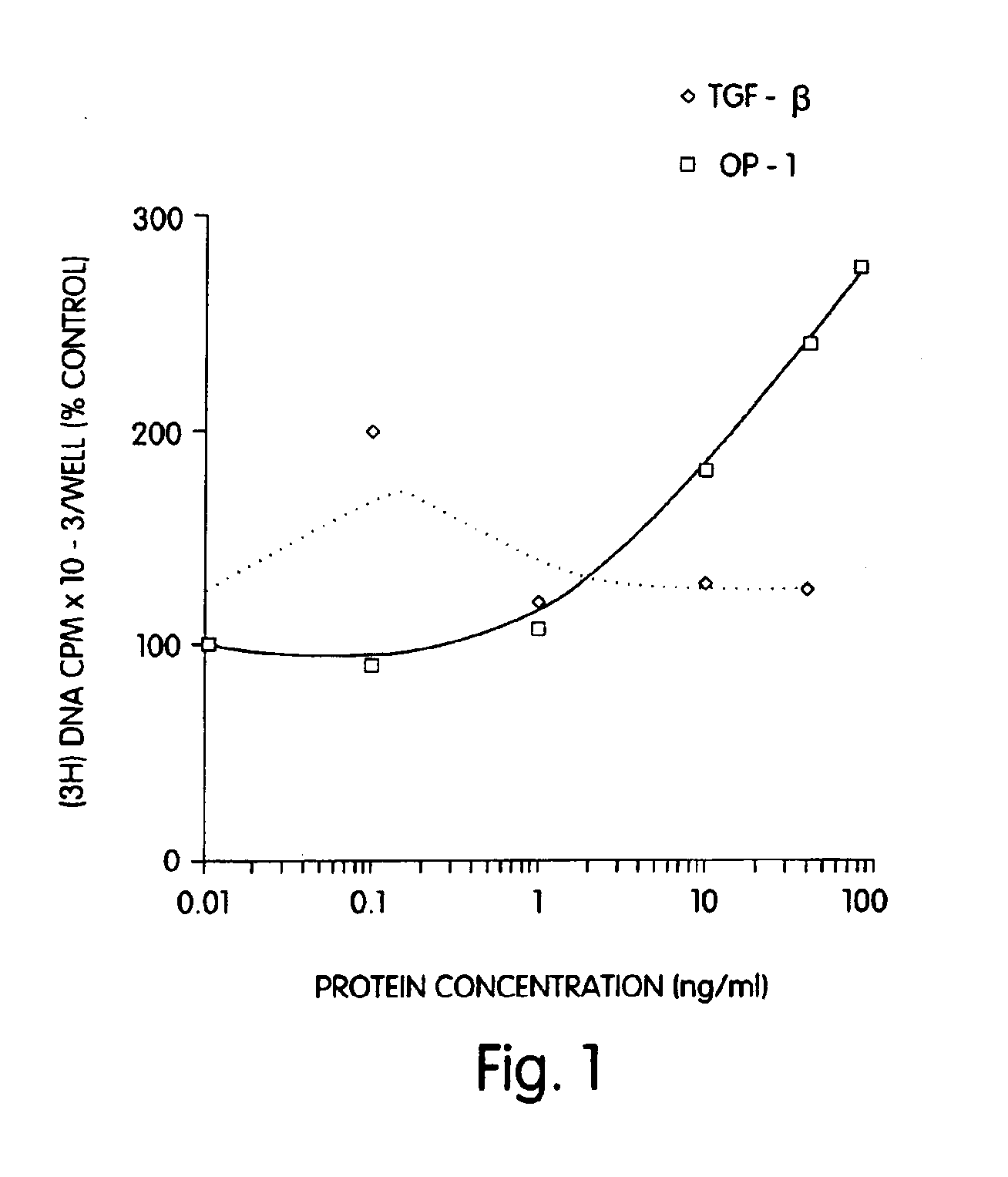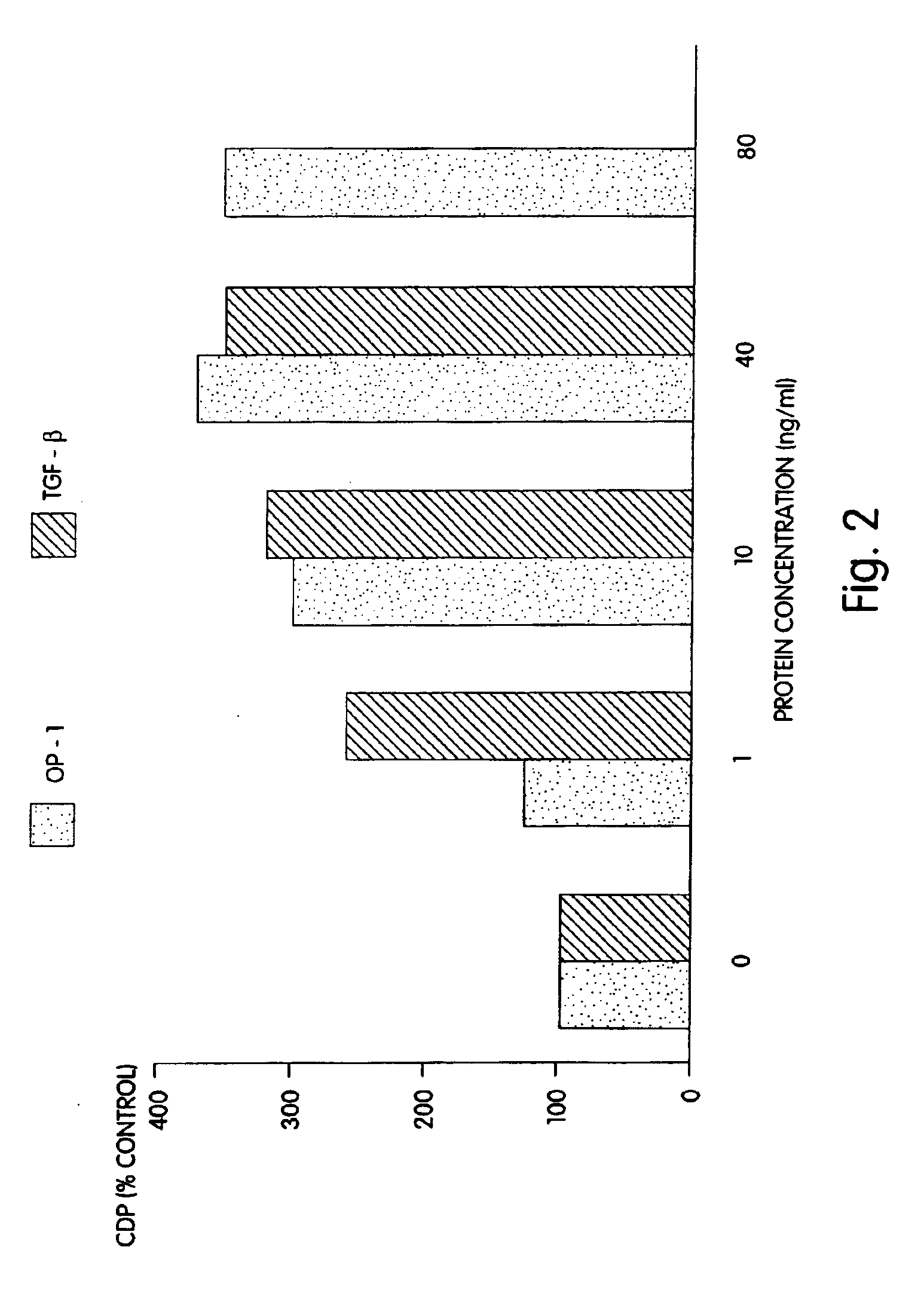Treatment to prevent loss of and/or increase bone mass in metabolic bone diseases
a metabolic bone disease and bone mass technology, applied in the field of metabolic bone disease treatment, can solve the problems of reducing the weight-bearing capacity of the affected bone, excessive bone mass loss at localized sites, and inability to prevent the loss of and/or increase the bone mass of metabolic bone diseases, so as to inhibit abnormal bone deterioration and enhance bone formation
- Summary
- Abstract
- Description
- Claims
- Application Information
AI Technical Summary
Benefits of technology
Problems solved by technology
Method used
Image
Examples
example 1
Identification of Morphogen-Expressing Tissue
[0080]Determining the tissue distribution of morphogens may be used to identify different morphogens expressed in a given tissue, as well as to identify new, related morphogens. Tissue distribution also may be used to identify useful morphogen-producing tissue for use in screening and identifying candidate morphogen-stimulating agents. The morphogens (or their mRNA transcripts) readily are identified in different tissues using standard methodologies and minor modifications thereof in tissues where expression may be low. For example, protein distribution may be determined using standard Western blot analysis or immunofluorescent techniques, and antibodies specific to the morphogen or morphogens of interest. Similarly, the distribution of morphogen transcripts may be determined using standard Northern hybridization protocols and transcript-specific probes.
[0081]Any probe capable of hybridizing specifically to a transcript, and distinguishin...
example 2
Mitogenic Effect of Morphogen on Rat and Human Osteoblasts
[0084]The ability of a morphogen to induce proliferation of osteoblasts may be determined in vitro using the following assay. In this and all examples involving osteoblast cultures, rat osteoblast-enriched primary cultures preferably are used. Although these cultures are heterogeneous in that the individual cells are at different stages of differentiation, the culture is believed to more accurately reflect the metabolism and function of osteoblasts in vivo than osteoblast culture obtained from established cell lines. Unless otherwise indicated, all chemicals referenced are standard, commercially available reagents, readily available from a number of sources, including Sigma Chemical, Co., St. Louis; Calbiochem, Corp., San Diego, and Aldrich Chemical Co., Milwaukee.
[0085]Rat osteoblast-enriched primary cultures were prepared by sequential collagenase digestion of newborn suture-free rat calvaria (e.g., from 1-2 day-old animals...
example 3
Effect of Morphogen on Collagen Synthesis in Rat Osteoblasts
[0089]The effect of a morphogen on collagen production in rat osteoblasts in vitro may be determined as follows.
[0090]Rat osteoblasts were prepared and cultured in a multi-well plate as described for Example 2. In this example a 24-well plate was used. The cultured cells then were divided into three groups: (1) wells which received 1, 10 or 40 ng of morphogen per ml of medium; (2) wells which received 1, 10 or 40 ng of a local-acting growth factor per ml of medium; and (3) a control group which received no growth factors. In this example, OP-1 was the morphogen tested, and TGF-β was the local-acting growth factor.
[0091]The samples were incubated for 68 hours at 37° C. with 5% CO2 in a humidified incubator. Twenty-five (25) μCi of 3H proline were added into each well and incubated for six additional hours. The cells then were frozen at −20° C. until the collagen assay was performed. The cells then were assayed for collagen p...
PUM
| Property | Measurement | Unit |
|---|---|---|
| weight | aaaaa | aaaaa |
| lengths of time | aaaaa | aaaaa |
| lengths of time | aaaaa | aaaaa |
Abstract
Description
Claims
Application Information
 Login to View More
Login to View More - R&D
- Intellectual Property
- Life Sciences
- Materials
- Tech Scout
- Unparalleled Data Quality
- Higher Quality Content
- 60% Fewer Hallucinations
Browse by: Latest US Patents, China's latest patents, Technical Efficacy Thesaurus, Application Domain, Technology Topic, Popular Technical Reports.
© 2025 PatSnap. All rights reserved.Legal|Privacy policy|Modern Slavery Act Transparency Statement|Sitemap|About US| Contact US: help@patsnap.com



